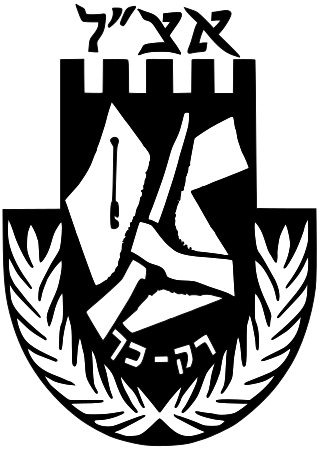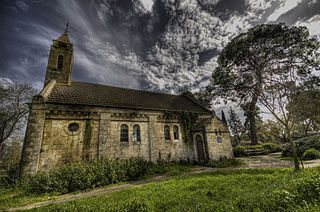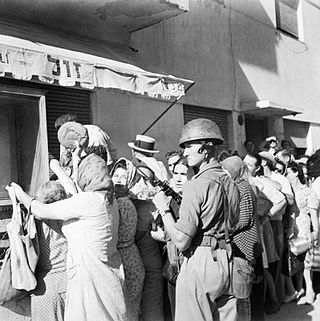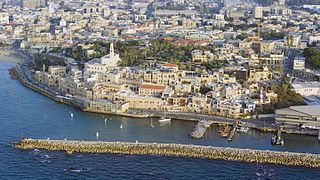Related Research Articles

The Irgun, or Etzel, was a Zionist paramilitary organization that operated in Mandate Palestine and then Israel between 1931 and 1948. It was an offshoot of the older and larger Jewish paramilitary organization Haganah. The Irgun has been viewed as a terrorist organization or organization which carried out terrorist acts.

Zionist political violence refers to politically motivated violence or terror perpetrated by Zionists. The term is used to describe violence committed by those who support the political movement of Zionism, and violence committed against opponents of Zionism. The violence often takes the form of terrorist attacks and has been directed against both Jewish and Arab targets. The most active period of most notable Zionist political violence began on June 30, 1924, through the 1940s, and continues to the present day, usually for the purpose of expanding Zionist settlements in Palestine.

Lehi, often known pejoratively as the Stern Gang, was a Zionist paramilitary militant organization founded by Avraham ("Yair") Stern in Mandatory Palestine. Its avowed aim was to evict the British authorities from Palestine by use of violence, allowing unrestricted immigration of Jews and the formation of a Jewish state. It was initially called the National Military Organization in Israel, upon being founded in August 1940, but was renamed Lehi one month later. The group referred to its members as terrorists and admitted to having carried out terrorist attacks.
Haganah was the main Zionist paramilitary organization that operated for the Yishuv in the British Mandate for Palestine. It was founded in 1920 to defend the Yishuv's presence in the region, and was formally disbanded in 1948, when it became the core force integrated into the Israel Defense Forces shortly after the Israeli Declaration of Independence.

Bethlehem of Galilee is a moshav in northern Israel. Located in the Galilee near Kiryat Tivon, around 10 kilometres north-west of Nazareth and 30 kilometres east of Haifa, it falls under the jurisdiction of the Jezreel Valley Regional Council. As of 2021 it had a population of 823.

Yishuv, Ha-Yishuv, or Ha-Yishuv Ha-Ivri denote the body of Jewish residents in Palestine prior to the establishment of the State of Israel in 1948. The term came into use in the 1880s, when there were about 25,000 Jews living in that region, and continued to be used until 1948, by which time there were some 630,000 Jews there. The term is still in use to denote the pre-1948 Jewish residents in Palestine, corresponding to the southern part of Ottoman Syria until 1918, OETA South in 1917–1920, and Mandatory Palestine in 1920–1948.

The Jewish Infantry Brigade Group, more commonly known as the Jewish Brigade Group or Jewish Brigade, was a military formation of the British Army in the Second World War. It was formed in late 1944 and was recruited among Yishuv Jews from Mandatory Palestine and commanded by Anglo-Jewish officers. It served in the latter stages of the Italian Campaign, and was disbanded in 1946.

Aliyah Bet was the code name given to illegal immigration by Jews, most of whom were refugees escaping from Nazi Germany, and later Holocaust survivors, to Mandatory Palestine between 1920 and 1948, in violation of the restrictions laid out in the British White Paper of 1939, which dramatically increased between 1939 and 1948. With the establishment of the State of Israel in May 1948, Jewish displaced persons and refugees from Europe began streaming into the new sovereign state.

Tatura is a town in the Goulburn Valley region of Victoria, Australia, and is situated within the City of Greater Shepparton local government area, 167 kilometres (104 mi) north of the state capital (Melbourne) and 18 kilometres (11 mi) west of the regional centre of Shepparton. At the 2021 census, Tatura had a population of 4,955.

Sarona is a neighborhood of Tel Aviv, Israel which started as a German Templer Colony in Palestine in 1871. It was one of the earliest modern villages established by Europeans in Ottoman Palestine. In July 1941, the British Mandate authorities deported 188 residents of Sarona, who were considered hard-core Nazi sympathizers. By the 2000s, the area had fallen into disrepair and was a haven for drug addicts. However, since 2003, the area has undergone massive renovation, which involved moving and relocating historical buildings before their restoration. The area is now a popular shopping district, as well as housing museums, cultural artifacts centering on its history, and IDF complexes.

Al-Shaykh Muwannis, also Sheikh Munis, was a small Palestinian Arab village in the Jaffa Subdistrict of Mandatory Palestine, located approximately 8.5 kilometers from the center of Jaffa city in territory earmarked for Jewish statehood under the UN Partition Plan. The village was abandoned in March 1948 due to the threats of Jewish militias, two months before the 1948 Arab–Israeli war. Today, Tel Aviv University lies on part of the village land.
As an organized nationalist movement, Zionism is generally considered to have been founded by Theodor Herzl in 1897. However, the history of Zionism began earlier and is intertwined with Jewish history and Judaism. The organizations of Hovevei Zion, held as the forerunners of modern Zionist ideals, were responsible for the creation of 20 Jewish towns in Palestine between 1870 and 1897.

A successful paramilitary campaign was carried out by Zionist underground groups against British rule in Mandatory Palestine from 1944 to 1948. The tensions between the Zionist underground and the British mandatory authorities rose from 1938 and intensified with the publication of the White Paper of 1939. The Paper outlined new government policies to place further restrictions on Jewish immigration and land purchases, and declared the intention of giving independence to Palestine, with an Arab majority, within ten years. Though World War II brought relative calm, tensions again escalated into an armed struggle towards the end of the war, when it became clear that the Axis powers were close to defeat.

Alonei Abba is a moshav shitufi in northern Israel. Located in the Lower Galilee near Bethlehem of Galilee and Alonim, in the hills east of Kiryat Tivon, it falls under the jurisdiction of the Jezreel Valley Regional Council. In 2021 it had a population of 1,000.

The 6th Airborne Division in Palestine was initially posted to the region as the Imperial Strategic Reserve. It was envisioned as a mobile peace keeping force, positioned to be able to respond quickly to any area of the British Empire. In fact the division became involved in an internal security role between 1945 and 1948.

HaKirya, or The Kirya, is an area in central Tel Aviv, consisting of an urban military base north of Kaplan Street, and a civilian area south of it.


Jaffa, in Hebrew Yafo and in Arabic Yafa and also called Japho or Joppa, is an ancient Levantine port city founded by the Canaanites that is now part of southern Tel Aviv, Israel. Sitting atop a naturally elevated outcrop on the Mediterranean coastline, it was a strategic location that exchanged hands repeatedly in ancient Near East history, and was also contested during the Crusades, when it presided over the County of Jaffa and Ascalon.
The German Templer colonies in Palestine were the settlements established in Ottoman Palestine and Mandatory Palestine by the German Pietist Templer movement in the late 19th and early 20th century. During and shortly after World War II, these colonies were depopulated, and its German residents deported to Australia.

The Old German Consulatebuilding is a historic building, built as the Consulate of the German Empire in the Templar neighborhood of "Walhalla" in Jaffa, nowadays part of Tel Aviv-Yafo. Its construction began in 1913, next to Nablus Road.
References
- ↑ Wawrzyn, Heidemarie (1 August 2013). Nazis in the Holy Land 1933-1948. De Gruyter. ISBN 978-3-11-030652-1.
On March 22, 1946, Gotthilf Wagner, the last mayor of Sarona and secretary of the Templers, was assassinated by the Hebrew Resistance Movement. A 2007 Israeli television documentary noted that the decision for this act was probably taken by the Haganah.
- 1 2 Wawrzyn, Heidemarie (1 August 2013). Nazis in the Holy Land 1933-1948. De Gruyter. ISBN 978-3-11-030652-1.
"In fact, Gotthilf Wagner had been a member of the Nazi party in Palestine. His membership no. 7024779 is recorded at the Public Record Office in London and the United States Holocaust Memorial Museum in Washington, D.C.
- 1 2 The Templers: German settlers who left their mark on Palestine: "...the assassination by Jewish militants of the former Templer mayor of Sarona, Gotthilf Wagner, sent shockwaves through the depleted community. Contemporary reports say Wagner was targeted because he had been a prominent Nazi."
- ↑ Wawrzyn, Heidemarie (1 August 2013). Nazis in the Holy Land 1933-1948. De Gruyter. ISBN 978-3-11-030652-1.
The assassination was intended to make it unmistakably clear that Palestine-Germans could no longer remain in the country.
- 1 2 3 Nachman Ben-Yehuda (1993). Political Assassinations by Jews. State University of New York Press. pp. 218–222.
- ↑ "German is murdered in Tel Aviv outskirts," pg 5, The New York Times, March 23, 1946.